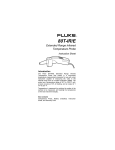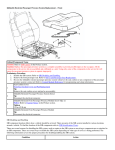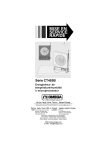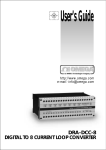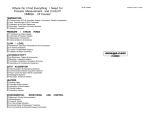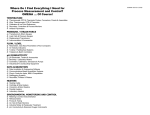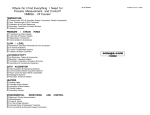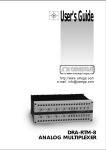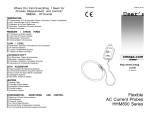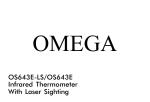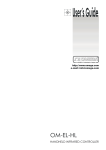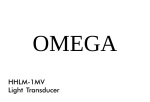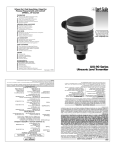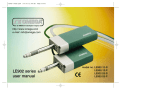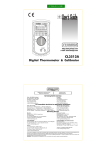Download HHM81 and HHM82 - OMEGA Engineering
Transcript
Where Do I Find Everything I Need for Process Measurement and Control? OMEGA ... Of Course! M-3481/0899 99-MAN 100181 UserÕs id TEMPERATURE 3 o o 3 o 3 o 3 3 o Thermocouple, RTD & Thermistor Probes, Connectors, Panels & Assemblies Wire: Thermocouple, RTD & Thermistor Calibrators & Ice Point References Recorders, Controllers & Process Monitors Infrared Pyrometers PRESSURE / STRAIN 3 Transducers & Strain Gauges o o 3 Load Cells & Pressure Gauges o 3 Displacement Transducers o 3 Instrumentation & Accessories FLOW / 3 o o 3 o 3 o 3 FORCE LEVEL Rotameters, Gas Mass Flowmeters & Flow Computers Air Velocity Indicators Turbine / Paddlewheel Systems Totalizers & Batch Controllers ON OL ! 300 V CAT III INPUT: 0-4.5 A DC / AC peak pH/CONDUCTIVITY 3 pH Electrodes, Testers & Accessories o o 3 Benchtop / Laboratory Meters 3 Controllers, Calibrators, Simulators & Pumps o o 3 Industrial pH & Conductivity Equipment • 1 mV/mA • OFF HHM81 DC/AC MICROPROBE ® DATA ACQUISITION 3 Data Acquisition & Engineering Software o 3 Communications-Based Acquisition Systems o o 3 Plug-in Cards for Apple, IBM & Compatibles o 3 Datalogging Systems o 3 Recorders, Printers & Plotters http:/www.omeg a.com e-mail: HEATERS 3 o o 3 o 3 o 3 o 3 Heating Cable Cartridge & Strip Heaters Immersion & Band Heaters Flexible Heaters Laboratory Heaters ENVIRONMENTAL 3 o o 3 o 3 o 3 o 3 3 o MONITORING AND Metering & Control Instrumentation Refractometers Pumps & Tubing Air, Soil & Water Monitors Industrial Water & Wastewater Treatment pH, Conductivity & Dissolved Oxygen Instruments CONTROL Model HHM81 Model HHM82 AC/DC Current Probes WARRANTY/DISCLAIMER OMEGA ENGINEERING, INC. warrants this unit to be free of defects in materials and workmanship for a period of 13 months from date of purchase. OMEGA Warranty adds an additional one (1) month grace period to the normal one (1) year product warranty to cover handling and shipping time. This ensures that OMEGA's customers receive maximum coverage on each product. If the unit should malfunction, it must be returned to the factory for evaluation. OMEGA's Customer Service Department will issue an Authorized Return (AR) number immediately upon phone or written request. Upon examination by OMEGA, if the unit is found to be defective it will be repaired or replaced at no charge. OMEGA's WARRANTY does not apply to defects resulting from any action of the purchaser, including but not limited to mishandling, improper interfacing, operation outside of design limits, improper repair, or unauthorized modification. This WARRANTY is VOID if the unit shows evidence of having been tampered with or shows evidence of being damaged as a result of excessive corrosion; or current, heat, moisture or vibration; improper specification; misapplication; misuse or other operating conditions outside of OMEGA's control. Components which wear are not warranted, including but not limited to contact points, fuses, and triacs. OMEGA is pleased to offer suggestions on the use of its various products. However, OMEGA neither assumes responsibility for any omissions or errors nor assumes liability for any damages that result from the use of its products in accordance with information provided by OMEGA, either verbal or written. OMEGA warrants only that the parts manufactured by it will be as specified and free of defects. OMEGA MAKES NO OTHER WARRANTIES OR REPRESENTATIONS OF ANY KIND WHATSOEVER, EXPRESSED OR IMPLIED, EXCEPT THAT OF TITLE, AND ALL IMPLIED WARRANTIES INCLUDING ANY WARRANTY OF MERCHANTABILITY AND FITNESS FOR A PARTICULAR PURPOSE ARE HEREBY DISCLAIMED. LIMITATION OF LIABILITY: The remedies of purchaser set forth herein are exclusive and the total liability of OMEGA with respect to this order, whether based on contract, warranty, negligence, indemnification, strict liability or otherwise, shall not exceed the purchase price of the component upon which liability is based. In no event shall OMEGA be liable for consequential, incidental or special damages. CONDITIONS: Equipment sold by OMEGA is not intended to be used, nor shall it be used: (1) as a "Basic Component" under 10 CFR 21 (NRC), used in or with any nuclear installation or activity; or (2) in medical applications or used on humans. Should any Product(s) be used in or with any nuclear installation or activity, medical application, used on humans, or misused in any way, OMEGA assumes no responsibility as set forth in our basic WARRANTY/DISCLAIMER language, and additionally, purchaser will indemnify OMEGA and hold OMEGA harmless from any liability or damage whatsoever arising out of the use of the Product(s) in such a manner. RETURN REQUESTS/ INQUIRIES Direct all warranty and repair requests/inquiries to the OMEGA Customer Service Department. BEFORE RETURNING ANY PRODUCT(S) TO OMEGA, PURCHASER MUST OBTAIN AN AUTHORIZED RETURN (AR) NUMBER FROM OMEGA'S CUSTOMER SERVICE DEPARTMENT (IN ORDER TO AVOID PROCESSING DELAYS). The assigned AR number should then be marked on the outside of the return package and on any correspondence. The purchaser is responsible for shipping charges, freight, insurance and proper packaging to prevent breakage in transit. FOR WARRANTY RETURNS, please have the following information available BEFORE contacting OMEGA: 1. P.O. number under which the product was PURCHASED, FOR NON-WARRANTY REPAIRS, consult OMEGA for current repair charges. Have the following information available BEFORE contacting OMEGA: 2. Model and serial number of the product under warranty, and 1. P.O. number to cover the COST of the repair, 3. Repair instructions and/or specific problems relative to the product. 3. Repair instructions and/or specific problems relative to the product. 2. Model and serial number of product, and OMEGA's policy is to make running changes, not model changes, whenever an improvement is possible. This affords our customers the latest in technology and engineering. OMEGA is a registered trademark of OMEGA ENGINEERING, INC. © Copyright 1996 OMEGA ENGINEERING, INC. All rights reserved. This document may not be copied, photocopied, reproduced, translated, or reduced to any electronic medium or machine-readable form, in whole or in part, without prior written consent of OMEGA ENGINEERING, INC. OMEGAnetSM On-Line Service: http://www.omega.com Internet e-mail: [email protected] Servicing North America: USA: ISO 9001 Certified Canada: One Omega Drive, Box 4047 Stamford, CT 06907-0047 Tel: (203) 359-1660 e-mail: [email protected] 976 Bergar Laval (Quebec) H7L 5A1 Tel: (514) 856-6928 e-mail: [email protected] FAX: (203) 359-7700 FAX: (514) 856-6886 For Immediate Technical or Application Assistance: USA and Canada: Mexico and Latin America: Benelux: Czech Republic: France: Germany/Austria: United Kingdom: 150 9002 Certified Sales Service: 1-800-826-6342 1-800-TC-OMEGASM Customer Service: 1-800-622-2378 / 1-800-622-BESTSM Engineering Service: 1-800-872-9436 / 1-800-USA-WHENSM TELEX: 996404 EASYLINK 62968934 CABLE: OMEGA Tel: (95) 800-TC-OMEGASM FAX: (95) 203-359-7807 En Espanol: (203) 359-1660 ext: 2203 e-mail: [email protected] Servicing Europe: Postbus 8034,1180 LA Amstelveen, The Netherlands Tel: (31) 20 6418405 FAX: (31) 20 6434643 Toll Free in Benelux: 06 0993344 e-mail: [email protected] Ostravska 767, 733 01 Karvina Tel: 420 (69) 6311627 e-mail: [email protected] FAX: 420 (69) 6311114 9, rue Denis Papin, 78190 Trappes Tel: (33) 130-621-400 FAX: (33) 130-699-120 Toll Free/France: 0800-4-06342 e-mail: [email protected] Daimlerstrasse 26, D-75392 Deckenpfronn, Germany Tel: 49 (07056) 3017 FAX: 49 (07056) 8540 Toll Free in Germany: 0130 11 21 66 e-mail: [email protected] 25 Swannington Road, Broughton Astley, Leicestershire, LE9 6TU, England Tel: 44 (1455) 285520 FAX: 44 (1455) 283912 P.O. Box 7, Omega Drive, Irlam, Manchester, M44 5EX, England Tel: 44 (161) 777-6611 FAX: 44 (161) 777-6622 Toll Free in England: 0800-488-488 e-mail: [email protected] It is the policy of OMEGA to comply with all worldwide safety and EMC/EMI regulations that apply. OMEGA is constantly pursuing certification of its products to the European New Approach Directives. OMEGA will add the CE mark to every appropriate device upon certification. The information contained in this document is believed to be correct but OMEGA Engineering, Inc accepts no liability for any errors it contains, and reserves the right to alter specifications without notice. WARNING: These products are not designed for use in, and should not be used for, patient connected applications. Maintenance Table of Contents Warning For maintenance use only specified replacement parts. · To avoid electrical shock, do not attempt to perform any servicing unless you are qualified to do so. · To avoid electrical shock and/or damage to the instrument, do not get water or other foreign agents into the case. Turn the Model HHM81/HHM82 OFF and disconnect the unit from all circuits before opening the case. · Also see warning on page 2. Warning ................................................................................................... 2 International Electrical Symbols............................................................. 2 Receiving Your Shipment....................................................................... 3 Packaging ............................................................................................... 3 Description .............................................................................................. 3 Specifications.......................................................................................... 5 Typical Frequency Response................................................................. 7 Battery Replacement · Remove probe from any conductor and place it away from any active conductors, circuitry, etc. · Unplug electronic module from display device (e.g., DMM, oscilloscope). · Remove the screws from the bottom cover of the electronic module. · Replace battery with a new 9 V alkaline type. · Replace bottom cover and re-attach with screws. Operating Procedure .............................................................................. 8 Making Measurements with the Models HHM81/HHM82................ 8 Indicator Lights .................................................................................. 8 Operation Examples ............................................................................... 9 DC Current Measurement ................................................................. 9 DC Current Measurement - Current Reversed ................................ 9 Two-Wire Sum-of-Currents ............................................................. 10 Cleaning To ensure optimum performance, it is important to keep the probe jaw mating surfaces clean at all times. Failure to do so may result in increased earth's field susceptibility and overall errors in readings. The following is the recommended procedure for cleaning the probe sensor: 1. Apply a few drops of isopropyl alcohol to an ordinary sheet of white photocopy paper. 2. Open probe to expose the mating surfaces of the sensor and insert the sheet of paper into the jaws. Allow the jaws to close. 3. With the jaws closed, pull free the end of the paper through the jaws until it releases. 4. Repeat step (3) several times, using a new (dry) section of paper each time. 5. Open probe and inspect mating surfaces. They should be free of dust particles or any other contamination. Otherwise, repeat the cleaning process starting again at step (1). 16 Two-Wire Current Differential ......................................................... 10 Oscilloscope Measurement (HHM81)............................................. 11 Maximum Step Discontinuity........................................................... 11 Measuring the DC Component of an (AC+DC) Waveform............ 12 Measuring the AC Component of an (AC+DC) Waveform ............ 12 Oscilloscope Measurement (HHM82)............................................. 13 Tips for Making Precise Measurements ......................................... 14 Residual Readings Following Severe Overloads........................... 15 Maintenance ......................................................................................... 16 Warning .......................................................................................... 16 Battery Replacement ..................................................................... 16 Cleaning ......................................................................................... 16 Warning These safety warnings are provided to ensure the safety of personnel and proper operation of the instrument. · Read the instruction manual completely and follow all the safety information before attempting to use or service this instrument. · Use caution on any circuit: Potentially high voltages and currents may be present and may pose a shock hazard. · Read the Safety Specifications section prior to using the probe. Never exceed the maximum voltage ratings given. · Safety is the responsibility of the operator. · NEVER open the back of the instrument while connected to any circuit or input. · ALWAYS connect the adapter to the display device before clamping the probe onto the sample being tested. · ALWAYS inspect the instrument, probe, probe cable, and output terminals prior to use. Replace any defective parts immediately. · NEVER use the probe on electrical conductors rated above 300 V in overvoltage category II (CAT II). International Electrical Symbols This symbol signifies that the probes are protected by double or reinforced insulation. Use only specified replacement parts when servicing the instrument. This symbol signifies CAUTION! and requests that the user refer to the user manual before using the instrument. 2 · Make sure that probe jaw mating surfaces are free of dust and contamination. Contaminants cause air gaps between sensor halves, making the Model HHM81/HHM82 susceptible to external magnetic fields which can contribute to measurement errors. See page 16 for cleaning procedure. · Do not allow probe jaws to abruptly snap closed from the open state. This can lead to residual readings. If this happens, the probes will need to be rezeroed. · Beware of short-circuit currents. Large in-rush currents (which can occur when power is first applied in a circuit) and large high-current transients may cause varying degrees of residual readings. If in doubt of a particular reading, remove the probe from the conductor under test and check to see that the display device returns zero. If not, it will be necessary to rezero the Models HHM81 and HHM82. · When using the probes to measure AC currents, keep in mind the maximum current ratings and the frequency response curves shown in the electrical specifications section. Dynamic currents that contain large step discontinuities and/or frequency constituents near or beyond the measurement passband are subject to measurements errors and waveform distortion (oscilloscope display). If the red LED comes on during measurement, the output signal may be in error. · Many DVMs provide null (relative) measurement capability. A DVM placed in the null mode displays the difference between a stored null value and the input signal. · You can use a DVMÕs null function in place of the external DC zero control to cancel any DC offset from the Models HHM81/HHM82. The DVM null function should be enabled with the probe removed from the conductor immediately before measurement. · You can use a DVMÕs null function to display changes in measured current from a fixed (constant) level. In this application, the DVM null function is enabled with the probe connected to the conductor. · When making null (relative) measurements, the probe aperture current (not displayed current) must not exceed the maximum ratings set forth in the specifications section. Residual Readings Following Severe Overloads · Large short-circuit and transient currents outside the operating range of the probe may cause large residual readings. In extreme cases they will not zero. If this happens: - Remove the probe from the test conductor. - Open the probe and release, allowing the jaws to snap back. Repeat this step several times. - Rezero the instrument before making successive measurements. 15 Tips For Making Precise Measurements · The Models HHM81 and HHM82 are capable of making measurements of DC and low frequency currents over a wide range. Here are some key considerations for getting the most accuracy from your displaying instrument: · When using the probes with a meter, it is important to select the range that provides the best resolution. Failure to do this may result in measurement errors. The following examples use an ordinary 3-1/2 digit DMM with the probes, to measure 16.7 mA DC: Resolution: 1 mV Display Error: 1.8% Resolution: 10 mV Display Error: 19.8% .017 V 20 20 2V V 20 V 16.7 MV 20 V 0m 20 2V V 0m V V 0m Model HHM81 20 .02 V 2V Resolution: 100µV Display Error: 0% PUSH PUSH PUSH DC Zero DC Zero DC Zero 16.7 mA Figure 10 Resolution: 1 mV Display Error: 0% Model HHM82 .167 V 20 V 2V 167.0 MV 20 V 2V 20 V 0m 20 V 0m V 2V V 0m 20 .17 V Resolution: 100µV Display Error: 0% 20 Resolution: 10 mV Display Error: 1.8% PUSH PUSH PUSH DC Zero DC Zero DC Zero Receiving Your Shipment Upon receiving your shipment, make sure that the contents are consistent with the packing list. Notify Omega of any missing items. If the equipment appears to be damaged, file a claim immediately with the carrier and notify Omega at once, giving a detailed description of any damage. Packaging The Models HHM81 and HHM82 include a electronic plug-in module with an attached current probe, 9 V battery, and user manual. Description These microprobes are low current measurement instruments that feature a compact, high sensitivity current probe. Unlike other instruments, the Model HHM81 exhibits a wide dynamic operating range, which extends from below 100µA to ± 4.5 A peak, from DC to 2.0 kHz*, without the need for ranging. The HHM82 has an operating range of 100µA to ± 450 mA Peak, from DC to 1500 Hz. This series is designed to be operated in conjunction with a digital multimeter, oscilloscope or recording device. The microProbe outputs the current measured in the form of a voltage that is the image of the current, in shape and amplitude. The Model HHM81 outputs 1 mV per mA of measured current. The Model HHM82 outputs 10 mV per mA of measured current. To take advantage of the Model HHM82Õs high sensitivity, best results are obtained through 4-1/2 digit (or more) DMM with a relative zero function. The Model HHM82 was designed to provide the operator with enhanced low current linearity and accuracy, but is limited to 450 mA Peak current. The microprobes always output a signal proportional to the total current (AC+DC) in the conductor under test. This has proven to be the most versatile signal output format, and allows the user to isolate and measure DC and AC components of measured current separately, if so desired. Typical applications include 4 to 20 mA loop measurements, automotive current applications, benchtop electronic current consumption in circuits, and other applications requiring very low current measurements in crowded areas. 16.7 mA Figure 11 14 3 Oscilloscope Measurement Example (HHM82) 1 7 2 · Conductor carrying a 0.2 A peak AC waveform · Model HHM82 connected to oscilloscope To Oscilloscope 2.0 V 3 0 ON 4 OL ! 300 V CAT III INPUT: 0-4.5 A DC / AC peak -2.0 V • 1 mV/mA • OFF 5 Current Waveform Oscilloscope Output 8 HHM81 ON OL 0.2 A 0 ! 300 V CAT III INPUT: 0-450 mA DC / AC peak -0.2 A • 1 mV/mA • OFF DC/AC MICROPROBE HHM82 DC/AC MICROPROBE ® ® Figure 9 6 1. Positive: Red banana plug (+) 2. Negative: Black banana plug (-) 3. Power ON indicator (green LED) 4. OVERLOAD indicator (red LED) 5. Power switch 6. Zero adjust knob (push in and turn to zero) 7. Probe window aperture 8. Probe handle 4 13 Measuring the DC Component of an (AC+DC) Waveform (HHM81) · Conductor carrying 20.0 mA DC + 15.0 mA AC · Voltmeter placed in DC Volts mode · Voltmeter displays 20.0 mV 15 mA AC + 20 mA DC DC CV V A 20.0 M V PUSH DC Zero Figure 7 Measuring the AC Component of an (AC+DC) Waveform (HHM81) · Conductor carrying 20.0 mA DC + 15.0 mA AC · Voltmeter placed in AC Volts mode · Voltmeter displays 15.0 mV HHM81 Specifications HHM82 Specifications ELECTRICAL ELECTRICAL Current Range: 0 to ± 4.5 A DC 0 to 3 Arms (sinusoidal) Current Range: 0 to ± 450 mA DC 0 to 300 mA rms Output (Vout): 1 mV/mA Output (Vout): 10 mV/mA Resolution: DC: 50µA typical AC: 100µA typical Resolution: DC: 50µA typical, AC: 100µA typical Accuracy: DC: 1% reading ± 200µA AC: 2% reading ± 200µA Accuracy: DC: 0.5% reading ± 150µA AC: 0.8% reading ± 200µA Output Noise: < 100µV, DC to 5 kHz Output Noise: <100µV, DC to 5 kHz Frequency Response: DC to 2 kHz (@ -3 dB sine) Frequency Response: DC to 1500 Hz (@ -3 dB sine) Zero Adjust: ± 25 mA Zero Adjust: ± 15 mA COMMON SPECIFICATIONS ELECTRICAL Rise Time: < 200µS, 10% to 90% Vout Fall Time: < 200µS, 90% to 10% Vout 15 mA AC + 20 mA DC DC CV V A 15.0 M V Output Impedance: 200W Probe Inductance: <1µH Influence of Adjacent Conductor: < 50µA/A Influence of Earth's Field: < 120µA, null to maximum PUSH DC Zero Figure 8 12 *Reference Conditions: Temperature 23¡C, 20 to 75% RH; battery voltage 9 V ± 0.1 V; earth's magnetic field < 40 A/m; absence of AC fields; input impedance of display device ³ 1 MW/100 pF; DC or sinusoidal AC current 45 - 65 Hz. 5 Common Specifications (cont.) MECHANICAL Oscilloscope Measurement Example (HHM81) To Oscilloscope 2.0 V Connectors: Two 4 mm banana jacks, standard 3/4" (19 mm) spacing 0 Maximum Conductor Diameter: 3/16Ó, 0.180" (4.5 mm) Overload LED (Red): Indicates momentary or continuous overload -2.0 V Oscilloscope Output Power LED (Green): Indicates power ON and good battery Battery: 9 V alkaline, NEDA 1604 or IEC 6 LF22 ON OL Current Waveform 2.0 A 0 ! 300 V CAT III INPUT: 0-4.5 A DC / AC peak • 1 mV/mA • OFF Dimensions (Probe): 4.4 x 0.6 x 1.0" (111 x 15 x 25 mm) HHM81 DC/AC MICROPROBE ® Dimensions (Electronic Module): 4.9 x 2.5 x 1.1" (124 x 64 x 28 mm) Cable Length: 5 ft (1.5 m) Weight: 9 oz (250 g) Figure 5 Operating Temperature: -14¡ to 131¡F (-10¡ to 55¡C) Storage Temperature: -40¡ to 176¡F (-40¡ to 80¡C) Maximum Step Discontinuity Example (HHM81) Humidity: < 95% @ ³ 35¡C, 75% @ 55¡C · Conductor carrying non-sinusoidal AC · Model HHM81 connected to oscilloscope · Max allowable step-discontinuity 2 A SAFETY SPECIFICATIONS The MicroProbes are designed to be used in conjunction with a digital multimeter or other instrument for the purpose of displaying measured readings. The Models HHM81 and HHM82 are safety rated as voltage probes. The user should ensure that they are connected to an instrument properly rated to international safety standards and/or agency approvals. Note: Step Discontinuities To Oscilloscope 2.0 V 0 Working Voltage: 300 V per IEC 1010-1 Cat. II Immunity (EN 50082-1), IEC 1000-4-3 aptitude criteria A: DC: 15mV @ 0, AC (60Hz): 2dB from 10 mA to 4.5A Emmissivity (EN 50081-1): negligible Drop Test: 1 m per IEC 1010 Current Waveform -2.0 V ON OL ! 300 V CAT III INPUT: 0-4.5 A DC / AC peak Oscilloscope Output DC/AC MICROPROBE ® Shocks: 100 G per IEC 68-2-27 Vibrations: IEC 529 Electromagnetic Compatibility: EN 50082-1 class A EN 50081-1 6 0 -2A • 1 mV/mA • OFF HHM81 Protection Index: IP 40 per IEC 529 2A Figure 6 11 Two-Wire Sum-of-Currents Example (HHM81) Typical · Two conductors in probe aperture (note orientations) · Voltmeter placed in DC Volts mode · Voltmeter displays 18.0 Mv Frequency Response Model HHM81 Typical Frequency Response 2200 2000 1800 1600 1400 1200 1000 800 600 400 0 DC CV -0.5 V 7 mA DC 11 mA DC PUSH DC Zero -1.0 Decibels (dB) A 18.0 M V 200 50 Frequency (Hz) -1.5 30 mA -2.0 3.0 A -2.5 -3.0 -3.5 Figure 3 -4.0 Two-Wire Current Differential Example (HHM81) · Two conductors in probe aperture (note orientations) · Voltmeter placed in DC Volts mode · Voltmeter displays -4.0 mV Model HHM82 Typical Frequency Response -0.5 -1.0 DC CV 7 mA DC 11 mA DC Decibels (dB) V A -4.0 M V 1600 0 1400 1200 1000 800 600 400 200 0 Frequency (Hz) -1.5 0 - 300 mA RMS -2.0 -2.5 -3.0 PUSH DC Zero -3.5 -4.0 Figure 4 10 7 Operating Procedure Making Measurements with the Models HHM81/HHM82 · Remove any conductor from within the probe jaws. · Plug the electronic module into the displaying device (e.g., DMM, oscilloscope). Note the polarity of the module output banana plugs (red = positive [+], black = negative [-]). · Select the appropriate range on displaying device (e.g., DMM, oscilloscope). Note that the module output is 1 mV/ mA for Model HHM81 and 10 mV/A for Model HHM82. Operation Examples DC Current Measurement Example (HHM81) · Conductor carrying 20.0 mA DC in the direction of the arrow · Voltmeter placed in DC Volts mode · Voltmeter displays 20.0 mV 20.0 M V DC Current Measurement Example - Current Reversed (HHM81) Indicator Lights - Green and Red LEDs · Conductor carrying 20.0 mA DC in opposite direction of arrow · Voltmeter placed in DC Volts mode · Voltmeter displays -20.0 mV DC Zero Figure 1 -20.0 M V DC CV V instrument. Readings taken while the red LED is ON or FLASHING should be considered inaccurate. Momentary or continuous currents exceeding ± 4.7 A for Model HHM81 and 470 mA for Model HHM82, and dynamic currents with large step discontinuities will cause the red LED to turn ON. 20 mA DC PUSH A · The red LED indicates a momentary or continuous overload of the DC CV V · The green LED indicates that the probe is ON and that the battery is good. The green LED will not light under low battery conditions. Replace the 9 V battery if the green LED is not lit. A · Turn displaying device power ON. Turn on the probe: the green LED should be ON, and the red LED OFF. · With the probe disconnected from test samples (no conductor in probe jaw window), adjust the zero control (push in the knob and turn) to read zero volts on the displaying device. In the unlikely event where the zero point is unobtainable, refer to ÒResidual Readings Following Severe OverloadsÓ section (pg. 15). The probe may be temporarily magnetized. · Clamp the probe around the conductor to be tested. The displaying device should now display the measured conductor current. In DC, a positive reading indicates current flowing in the direction of the arrow on the probe. A negative reading indicates current flow in the opposite direction of the arrow. 20 mA DC PUSH DC Zero Figure 2 8 9










